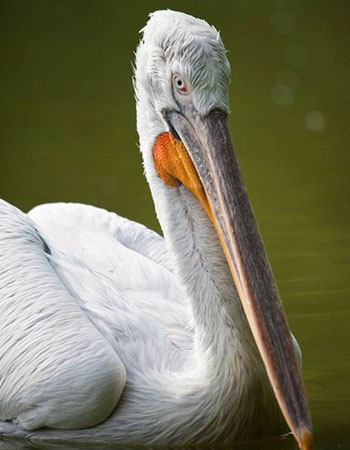Participatory Planning Achieves Conservation Success for Dalmatian Pelicans

Dalmatian Pelicans © Sergey Dereliev (UNEP/AEWA), www.dereliev-photography.com
Bonn, 17 April 2015 - A recent conservation project has utilized the power of participatory planning to enable the successful protection of Dalmatian Pelican habitat in Montenegro. Funded by the Convention on Migratory Species (CMS) through its Small Grant Programme and led by the French NGO Noé Conservation, the project has successfully engaged stakeholders to implement a conservation zone around a key Dalmatian Pelican nesting area on the shores of the Skadar Lake in Southern Montenegro.
A migratory species, the Dalmatian Pelican is considered particularly striking, characterized by its silvery-white plumage, orange pouch and yellow-purple skin around its eyes. With substantial population declines occurring during the 19th and 20th centuries, the Dalmatian Pelican is classified as Vulnerable on the IUCN Red List and is protected under CMS, CITES and the Bern Convention as well as the European Birds Directive.

For the Skadar Lake colony, an 80% decrease in population since the 1970s sparked the need for significant conservation action. This conservation need was made eveore pressing given the Dalmatian Pelican’s significance as the emblem for the Skadar Lake National Park and a biodiversity indicator for the ecological health of the lake.
In succession to projects on colony monitoring and promotion of Pelican-friendly tourism, the project “Setting up the zonation in Pančeva oka, Lake Skadar” aimed to establish a protected area for Dalmatian Pelicans in the Pančeva oka nature reserve of Skadar Lake. In collaboration with Public Enterprise National Parks Montenegro, the Natural History Museum of Montenegro, the Centre for Protection and Research of Birds, EuroNatur and Tour du Valat, an initial protection zone was established, taking key feeding and nesting sites into consideration.
Dalmatian Pelicans on Skadar Lake are facing several anthropic and natural pressures. One prominent natural threat is the flooding of nests after heavy rains, which can raise the water level by more than five metres and engulf nests made on natural islets. To mitigate this threat, four nest rafts were successfully designed and deployed in the Pelican’s nesting habitat to allow the nests to safely rise and fall with the changing water level.
The project then set about tackling a key human threat through deploying floating buoys as a physical boundary marker for the protection zone. This was of particular importance as local fishermen had continued to undertake prohibited activities inside the protection zone due to a lack of demarcation. The deployment of buoys was conducted in conjunction with educational initiatives such as local community meetings and TV appearances to help raise awareness of the protection zone.
However, following the vandalism of the marker buoys, it was decided a new approach was needed. A participatory planning workshop was held, bringing together local fishing associations, scientific experts, conservation managers and other local institutions to discuss the vandalism and to decide on a new plan to protect Dalmatian Pelican habitat. The meeting was a success, culminating with an agreement between all stakeholders on a new zonation plan that would ensure protection of key nesting sites whilst minimizing impacts to fishing activities undertaken on Skadar Lake.
As all local stakeholders have been supportive of the new zonation plan since the workshop, the project offers an inspiring example of the use of participatory planning to shift stakeholders from conflict based positions to a cooperative interaction with conservation efforts. This has contributed to positive conservation outcomes on the ground and a common basis for future conservation projects on the Dalmatian Pelican and the Skadar Lake ecosystem.
The zonation project at Lake Skadar is part of a wider initiative lead by Noé Conservation to conserve Dalmatian Pelicans and improve wetland management in the Mediterranean Basin.
For more information please contact the CMS Head of Avian Species, Dr. Borja Heredia at borja.heredia@cms.int
Last updated on 17 April 2015


